
Your Site﹥﹥homepage﹥Hall of Fame﹥Lin Siansheng
| Hall of Fame | Chang-ling Shih | Shih-cing Huang | Lin Siansheng |
Lin Siansheng
When talking about Babao Canal of Changhua County, it is necessary to discuss the figure of “Lin Siansheng.” “Lin Siansheng” was a well-known key figure in hydraulics. He not only cleared Babao Canal and conveyed its water, but was also an outstanding hydraulics engineer in the history of Taiwan. Later generations called him “Great Yu of Taiwan” and “father of the dams.”
According to legend, “Lin Siansheng” appeared suddenly and disappeared suddenly, it was almost difficult to know if he was ever there. After his achievement, he left quietly without claiming his reward. Who exactly was this “Lin Siansheng,” who only had a surname but no last name? Why did he contribute his wisdom for great works, but did not leave his name? This is still a mystery today. Now, only existing records and folk legends could be explored to remember his grace and virtuous work.
1. “Chronicles of Changhua County”: Called himself Lin Siansheng.
“Changhua County Chronicles•People” recorded a biography of “Lin Siansheng” who helped Shih-bang Shih to construct Babao Canal: “Lin Siansheng, an unknown person, with plain clothing and elegant way of speaking. When he met the commander of soldiers and horses Shih-bang Shih, he said: “I heard that you wanted to improve profit for Changhua, and this would be a significant work, but you do not know the method, so I will help you”. Shih asked him his name but he only smiled and said nothing. He asked again, then the man said, “Just call me Lin Siansheng!”, and later he came with the diagram and methods. ……
This explained that the name “Lin Siansheng” came from his self-reference, or that he told Shih-bang Shih about the name “Lin Siansheng.”
2. Lin Siansheng was a hired engineering designer.
Zheng Mengxing’s “Haian Jiufang Shih and Babao Canal in Taiwan”: “Anhai Jiufang Mr. Yang-cheng Shih had spoken of a legend about Lin Siansheng. According to him, he set up a placard to attract capable people to construct the canal, and Lin Siansheng applied in response.”
As previously stated, Lin Siansheng was an engineer hired by the Shih family, but did not explain whether the surname “Lin” was given when he was hired, or for some other reason.
3. Lin Siansheng was an official from the Ming Dynasty and did not want to leave his name.
One perspective was that at the construction of Babao Canal, Taiwan was under Qing rule. Some officials or faithful scholars from the end of the Ming Dynasty remaining in Taiwan could only conceal their names and hide in the mountains. Thus, some people believe that “Lin Siansheng” was probably among this group. Even though he assisted Qing Dynasty officials (Shih-bang Shih and his father were selection tributes, and worked as vice commanders of the soldiers and horses bureau, so they had formal titles and merits) in hydraulics, he just wanted to do some good work rather than serve officials. So after he achieved his work, it was normal to not have left his name.
This view basically came from positive imagination for wise men in the forest, but, the name “Lin Siansheng” has not yet been ascertained even now, there is no way to deduce and verify the identity. Thus, this view could only serve as a reference and room for imagination, but could be truly verified.
4. The man left his shoes between trees, so the people guessed that his name was “Lin Siansheng”.
According to legend, after this old man helped the Babao Canal to convey water, he disappeared and villagers could not find him. Later, near the water diversion gate of Babao Canal (the current location of “Linsiansheng Temple”), they found the shoes worn by the old man, neatly placed between two trees. Therefore, they guessed that his surname was “Lin,” and in turn respectfully called him “Lin Siansheng”, using this as the name of the temple.
This is exactly like the previous view, an imagined story without definitive evidence, even becoming myth-like.
5. “Lin” comes from the material and style of canal construction.
A poem was written in “Chronicle of Taiwanese Culture”, which recorded the canal construction secrets passed down by the Shih family:
The Shih family dug a canal for irrigation, leading the water of Jhuoshuei to the west; much of the grass is in desire for water, the deep water source has wood as dams; Along with the mountains it flows south to north, see the form of the water for the low area; fifteen gourds are the same way, all belonging to these two rivers.
According to the analysis by Shui-yuan Chen, in the fourth line, “the deep water source has wood as dams,” “wood as dams,” refers to the method of inserting vertical wooden pillars as the “canal shores” on the two sides of the canal. Thus, the “wood” on the two sides forms the character for “Lin,” and this may be the source of the name “Lin Siansheng,” since only “erecting wood as dams” can maintain the safety of the shores of the dam. This is an important measure in water control methods, this can also be seen as a “powerful contributor” to the construction of Babao Canal.
Even though this still sounds like legend, it still explains that while the opening of Babao Canal was a major contribution by the Shih family, the canal construction method is also a significant and indelible page in the history of hydraulic engineering.
6. Representation of the unnamed hydraulics engineers among those who opened the canal.
Since the story of Lin Siansheng had mythical characteristics, it makes people doubt whether he was real, and he may have been an imaginary figure.
However, Babao Canal was the first large-scale hydraulic construction introduced from China with slope canal structure, and was a difficult work, thus there had to have been engineers who participated. In the hydraulics engineering process, there should have been personnel who conducted overall planning and guidance. Among them, there should have been a man who called himself Lin Siansheng, who did not want to take credit after the great work was complete. Thus, the villagers constructed “Linsiansheng Temple”, still seeking to commemorate the great merit of those who were responsible for opening the canal.
7. Summary
Although the reality of Lin Siansheng has been in doubt, opening of Babao Canal did benefit the people of Changhua. The “Linsiansheng Temple” constructed by the farmers in commemoration of ancestors is the only temple in Taiwan that has no statues of deities but also rank plaques. At the same time, the major contributors to the canal, Lin Siansheng, Chang-ling Shih, and Shih-cing Huang were housed in a temple for worship. This shows the moral significance in folk customs, in which after many years, people still had the spirit of “drinking water and thinking of its source” for people who have benefitted them. They continue to worship and remember them, and the temple is still popular. As for whether “Lin Siansheng” was truly a historical figure, he has already transformed into a collective name for all the people who helped to open the canal, coexisting with the gratitude and cherishing emotions of the people.
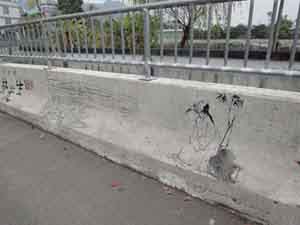 |
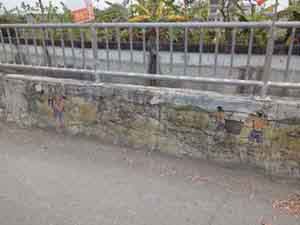 |
||
| The legend of Lin Siansheng drawn on Babao Canal. (shot in 2010, the traces of the drawing are old.) |
The scenery of farm cultivation is also drawn.
(shot in 2010, the traces of the drawing are old. ) |
||
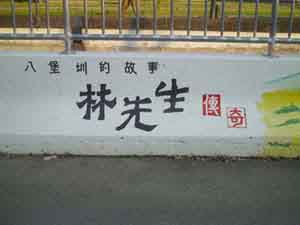 |
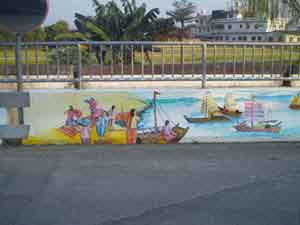 |
||
| The legend of Lin Siansheng drawn on Babao Canal. (shot in 2011, re-painted by the town hall) |
The cultivation of farmland at the time.
(shot in 2011, re-painted by the town hall) |
||
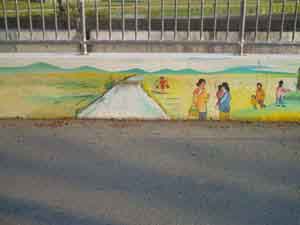 |
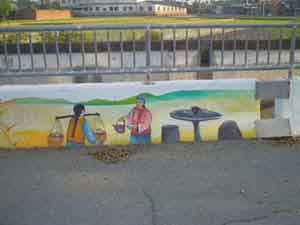 |
||
|
The old and young working hard by the canal.
(shot in 2011, re-painted by the town hall) |
The workers recruited for cultivation carrying stones on their shoulders. (shot in 2011, re-painted by the town hall) |
||
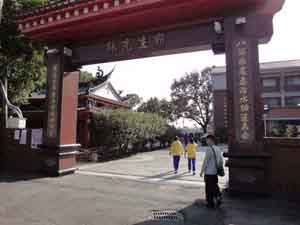 |
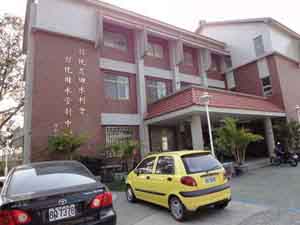 |
||
| The gate of Linsiansheng Temple, located on Yuanji Road, across from Babao Canal. | Changhua County Irrigation Association is located within Linsiansheng Temple. | ||
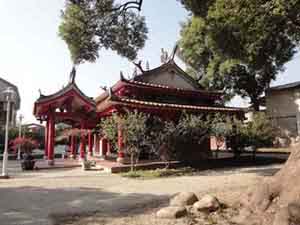 |
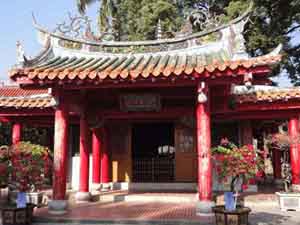 |
||
| The ancient Linsiansheng Temple is a building with two-tiered rectangular eaves. | The rank plaques for worship in Linsiansheng Temple. | ||
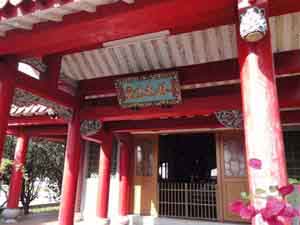 |
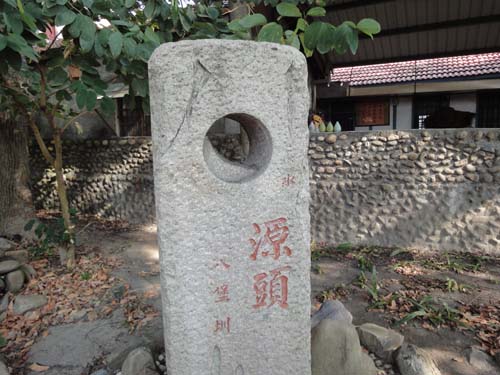 |
||
| The rank plaques for worship in Linsiansheng Temple, also the site of gratitude ritual each year. | The stone tablet at the head of Babao Canal, marking the position where the Babao Canal began in construction. |